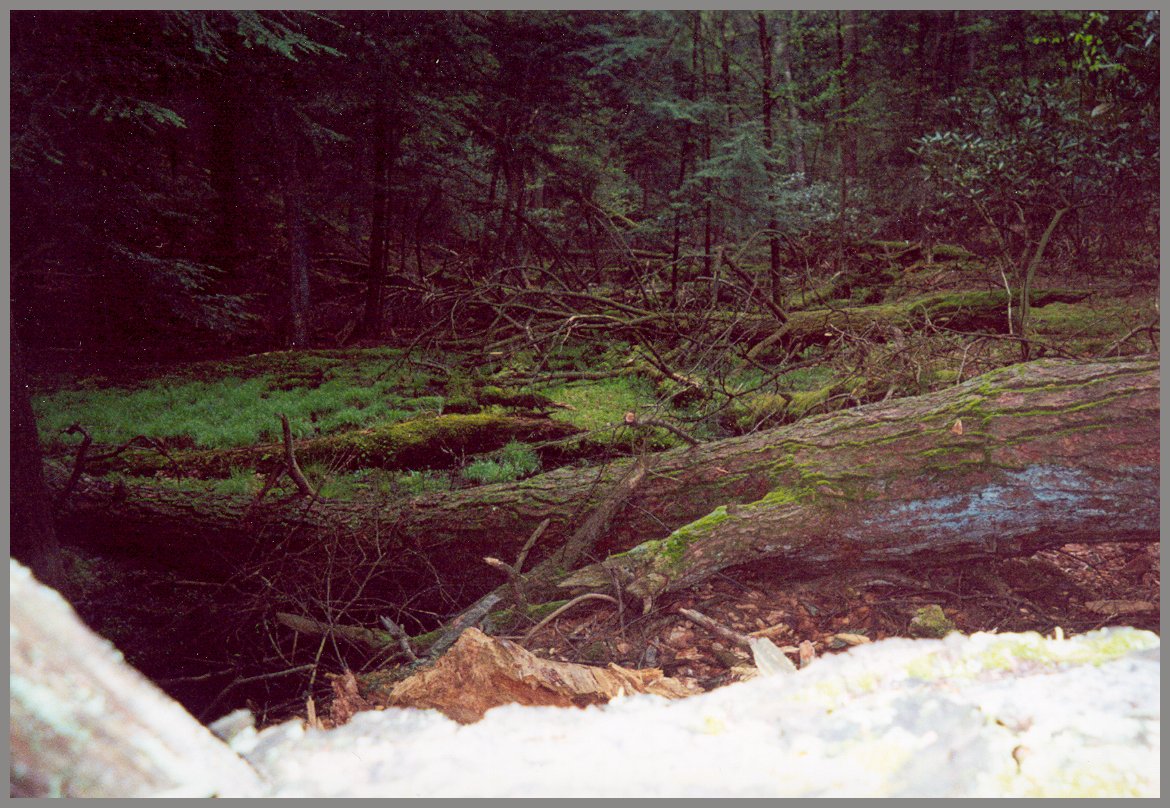Allochthonous Input -
Organic material that falls into a stream from the surrounding land is
 known
as allochthonous input. Combined with the instream accumulation of primary
production by algae and vascular plants — the autochthonous input —
allochthonous input provides the support system for all instream life.
Allochthonous inputs span a broad range of sizes; from leaf fragments to
branches and entire trees. Although the size range of these inputs is
continuous, individual pieces typically are classified by size and function
and grouped for convenience. Fine paniculate organic material (FPOM)
encompasses all particles that will pass through a .04-inch (1.0-mm) fine
mesh sieve. The largest pieces of wood, known as large or coarse woody
debris (CWD), typically are greater than three feet in length and at least 2
to 4 inches in diameter. In between is CPOM or coarse paniculate organic
material.
known
as allochthonous input. Combined with the instream accumulation of primary
production by algae and vascular plants — the autochthonous input —
allochthonous input provides the support system for all instream life.
Allochthonous inputs span a broad range of sizes; from leaf fragments to
branches and entire trees. Although the size range of these inputs is
continuous, individual pieces typically are classified by size and function
and grouped for convenience. Fine paniculate organic material (FPOM)
encompasses all particles that will pass through a .04-inch (1.0-mm) fine
mesh sieve. The largest pieces of wood, known as large or coarse woody
debris (CWD), typically are greater than three feet in length and at least 2
to 4 inches in diameter. In between is CPOM or coarse paniculate organic
material.
Source: (Dolloff, Andrew and Jackson
R. Webster [In: Verry, E. S., Hornbeck, J. W., James W.; Dolloff, C.,
Andrew, C, eds.] 2000 (Chapter 7) Particulate Organic Contributions from
Forests to Streams: Debris isn't So Bad [In: Riparian management in forests
of the continental Eastern United States.]) jk-83
Dictionary MAIN
PAGE
Text & Graphics Copyright © 2009
Keslick & Son Modern Arboriculture
Please report web site problems, comments and words of interest,
not found.
Contact
 known
as allochthonous input. Combined with the instream accumulation of primary
production by algae and vascular plants — the autochthonous input —
allochthonous input provides the support system for all instream life.
Allochthonous inputs span a broad range of sizes; from leaf fragments to
branches and entire trees. Although the size range of these inputs is
continuous, individual pieces typically are classified by size and function
and grouped for convenience. Fine paniculate organic material (FPOM)
encompasses all particles that will pass through a .04-inch (1.0-mm) fine
mesh sieve. The largest pieces of wood, known as large or coarse woody
debris (CWD), typically are greater than three feet in length and at least 2
to 4 inches in diameter. In between is CPOM or coarse paniculate organic
material.
known
as allochthonous input. Combined with the instream accumulation of primary
production by algae and vascular plants — the autochthonous input —
allochthonous input provides the support system for all instream life.
Allochthonous inputs span a broad range of sizes; from leaf fragments to
branches and entire trees. Although the size range of these inputs is
continuous, individual pieces typically are classified by size and function
and grouped for convenience. Fine paniculate organic material (FPOM)
encompasses all particles that will pass through a .04-inch (1.0-mm) fine
mesh sieve. The largest pieces of wood, known as large or coarse woody
debris (CWD), typically are greater than three feet in length and at least 2
to 4 inches in diameter. In between is CPOM or coarse paniculate organic
material.